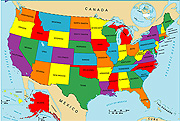- Double Mastectomy May Offer No Survival Benefit to Women With Breast Cancer
- Toxic Lead Found in Cinnamon Product, FDA Says
- Certain Abbott Blood Sugar Monitors May Give Incorrect Readings
- Athletes Can Expect High Ozone, Pollen Counts for Paris Olympics
- Fake Oxycontin Pills Widespread and Potentially Deadly: Report
- Shingles Vaccine Could Lower Dementia Risk
- Your Odds for Accidental Gun Death Rise Greatly in Certain States
- Kids From Poorer Families Less Likely to Survive Cancer
- Tough Workouts Won’t Trigger Cardiac Arrest in Folks With Long QT Syndrome
- At-Home Colon Cancer Test Can Save Lives
200,000 Heart Disease, Stroke Deaths Could Be Prevented: CDC


TUESDAY, Sept. 3In 2010, more than 200,000 Americans under 75 died from heart disease and stroke that could have been prevented, health officials said Tuesday.
Sadly, more than half of those who died were under 65, according to a new report released by the U.S. Centers for Disease Control and Prevention.
“As a doctor, I find it heartbreaking to know that the vast majority of people who are having a heart attack or stroke, under the age of 65 in particular, and dying from it didn’t have to have that happen,” CDC director Dr. Tom Frieden said during a noon press conference.
But progress has been made, Frieden said. “The rate of preventable deaths from heart disease and stroke decreased by nearly 30 percent between 2001 and 2010,” he noted.
Most of this progress, however, has been made among those older than 65. And while these are the people who have the highest risk, most of preventable deaths happen to people under 65. “In that group progress has been much slower,” Frieden said.
This dichotomy may be because those 65 and older have Medicare with its access to screening and treatment, Frieden suggested.
But where a person lives is also a factor in the equation, he added. “It’s unfortunate, but your longevity may be more likely to be influenced by your ZIP code than by your genetic code,” he said. “In fact, what we have seen is a striking convergence of risk factors in the Southern states.”
Race and ethnicity also play a part, with blacks at twice the risk of dying from heart disease or stroke unnecessarily than whites, Frieden stated. “In fact, race is the single largest contributor to racial differences in life expectancy,” he pointed out.
Sex is also a contributor, with men twice as likely to die from a preventable heart attack or stroke than women, the findings showed.
The United States doesn’t stack up well against other countries when it comes to the rate of cardiovascular deaths, Frieden noted. “The overall rate of cardiovascular death in the U.S. is about 50 percent higher than many similar countries around the world,” he said.
Each year in the United States nearly 800,000 people die from heart disease or stroke, many of which could have been prevented by proper medical management and lifestyle changes to control risk factors, Frieden said.
According to Dr. Gregg Fonarow, a spokesman for the American Heart Association, “Cardiovascular disease remains the leading cause of death in men and women in the United States.” Fonarow is also a professor of cardiology at the University of California, Los Angeles.
“Many of these cardiovascular deaths would be entirely avoidable with better implementation of preventative measures and effective treatments,” Fonarow added.
Local, regional and national efforts are urgently needed to improve cardiovascular health and reduce death and disability due to heart disease and stroke, Fonarow said.
“Individuals can proactively lower their risk for cardiovascular disease and stroke by getting active, maintaining healthy blood pressure, cholesterol levels, weight and diet as well as avoiding smoking,” Fonarow said.
“Adopting healthier choices and effective preventative therapies can have an immediate effect on one’s cardiovascular risk and help avoid becoming one of these preventable cardiovascular deaths,” he added.
The CDC believes communities and health departments can help by providing healthy living spaces, including tobacco-free and safe walking areas, and ensuring access to healthy foods.
Highlights of the report published Sept. 3 in the CDC’s Morbidity and Mortality Weekly Report include:
- In 2010, death rates were highest among those aged 65 to 74 (401.5 per 100,000 population).
- Preventable deaths have dropped faster among those 65 to 74 compared to those under 65.
- Compared to women, men are more than twice as likely to die from preventable heart disease or stroke.
- Compared to whites, blacks are twice as likely — and Hispanics are slightly less likely — to die from preventable heart disease and stroke.
- Avoidable deaths from heart disease, stroke and high blood pressure were higher among men (nearly 84 per 100,000) than women (about 40 per 100,000). Black men have the highest risk.
- Compared to Hispanic women, Hispanic men are twice as likely to die from preventable heart disease and stroke.
- Preventable deaths varied by state from a low of about 36 deaths per 100,000 people in Minnesota to a high of more than 99 per 100,000 in the District of Columbia.
- By county, the highest rates of avoidable death were mostly in the southern Appalachian region, Tennessee, Arkansas, Mississippi, Louisiana and Oklahoma. The lowest rates were in the West, Midwest, and Northeast regions.
More information
For more information on preventing cardiovascular disease, visit the American Heart Association.
Source: HealthDay
Copyright © 2024 HealthDay. All rights reserved.










